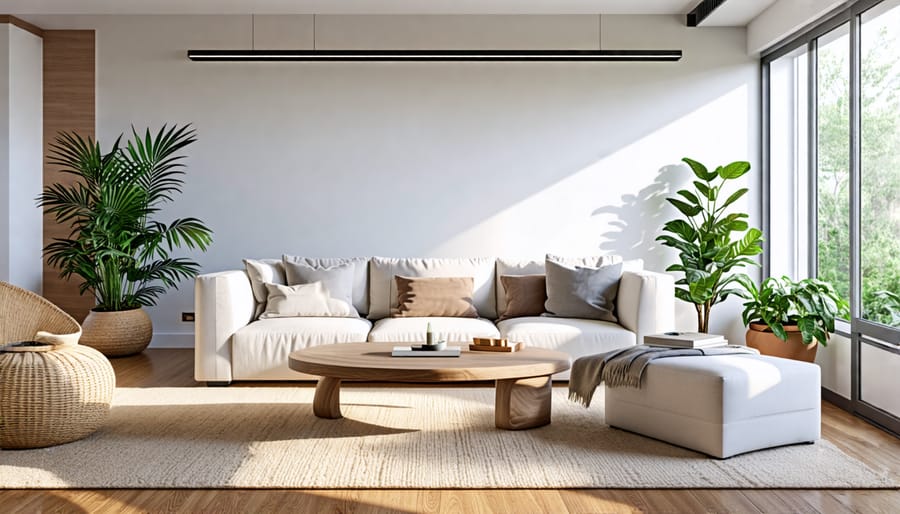
Unlock the Secrets of Interior Design: Elevate Your Space with Key Principles and Elements
Transform your space with these foundational elements: balance contrasting colors while maintaining harmony by choosing a dominant shade; create a focal point using a statement piece like art or furniture to capture attention; optimize space with strategic furniture placement for both functionality and flow. Elevate your design with texture by blending various materials like wood, metal, and fabric. Experiment with lighting layers to add depth and ambiance, balancing natural and artificial sources to tailor each room’s mood.
The Key Principles of Interior Design
Balance and Harmony
Creating a visually pleasing environment starts with understanding the principles of balance and harmony in interior design. Balance involves distributing visual weight evenly throughout a room, ensuring that no single area overwhelms the space. Harmony, on the other hand, is achieved by creating a sense of coherence among the various elements in a room. This can be done by choosing complementary colors, materials, and textures that seamlessly blend together, promoting a tranquil atmosphere. For instance, pairing soft, neutral-colored furniture with natural textures can evoke a serene aesthetic, echoing the essence of nature in your home.
Incorporating these ideas fosters a welcoming environment that invites relaxation and ease. To begin experimenting in your own space, try incorporating cozy home decor ideas, such as strategic lighting arrangements or using symmetry to balance key focal points. Whether you’re a homeowner or a DIY enthusiast, mastering balance and harmony can transform any room into a sanctuary of peace and style.

Proportion and Scale
Proportion and scale are crucial in elevating the dynamics and aesthetics of a room, creating spaces that feel harmonious and balanced. Imagine walking into a living room where the furniture is oversized for the space; it feels cramped and overwhelming. Conversely, a large room with tiny furniture pieces seems sparse and uninviting. Getting the proportion and scale right means selecting furnishings and decor that complement the room’s dimensions and each other, creating a cohesive look. Start by measuring the dimensions of your room and considering the height of ceilings, size of windows, and architectural features. A taller ceiling, for instance, might be beautifully accented by taller furniture pieces or vertical artwork. Mixing different scales—such as combining a large sectional sofa with smaller accent chairs—adds visual interest and functionality. Experiment with DIY projects, like creating custom shelves, that fit proportionally to your walls, ensuring every element contributes to a balanced and appealing space. These thoughtful choices make rooms more inviting and visually connected, a delight for occupants and visitors alike.
Rhythm and Repetition
Rhythm and repetition in interior design are your secret weapons for establishing a sense of movement and flow. Think of these principles as the beat that keeps a melody captivating, guiding eyes seamlessly across the space. By repeating elements like color, pattern, or texture, you create consistency, making rooms feel harmonious and connected. Imagine using similar patterns on your curtains and cushions; this simple repetition creates unity. For the DIY enthusiasts, consider alternating light fixtures or frames evenly along a wall for visual cadence. These techniques invite smooth transitions between spaces, making your home not only stylish but cohesively engaging.
Focus and Emphasis
Creating a focal point in your space is all about guiding the eye and adding emphasis where it matters most. Start by choosing a primary area—like a fireplace, a stunning piece of art, or a large window with a beautiful view—and build the room’s design around it. Use contrast through color, texture, or lighting to make this element stand out. Consider incorporating bold accessories or furniture to draw attention, or employ a DIY project such as a feature wall to infuse personality. These techniques will help guide attention and create visual harmony, enhancing the overall appeal of your space.
Exploring the Elements of Interior Design
Color, Line, and Texture
Color, line, and texture are fundamental elements that transform a space’s mood and tone, infusing it with personality and style. Picture walking into a room awash in calming blues and greens; it immediately sets a tranquil vibe, ideal for spaces meant for relaxation, like bedrooms or living rooms. On the other hand, bold colors like reds and oranges can energize a space, perfect for lively areas like playrooms or kitchens. Lines guide the eye; horizontal lines can make a space feel more expansive, while vertical lines emphasize height and elegance, often used in dining areas or entryways.
Texture adds depth, making an interior visually and physically rich. Smooth textures, like polished stone or glass, reflect light and can brighten up a space, giving it a modern feel. In contrast, rough textures, such as reclaimed wood or a shaggy rug, create warmth and coziness, ideal for intimate spaces like reading nooks. For a balanced look, consider mixing these elements: a soft leather couch paired with a sleek metal lamp introduces both comfort and sophistication. Next time you consider a design change, remember that tweaking these elements can be a simple yet effective DIY project, perfect for refreshing your environment without a full overhaul.

Shape and Form
Shape and form in interior design are powerful tools that can transform how a room is perceived and utilized. The shapes used in a space, whether geometric like squares and circles or organic like freeform curves, can evoke different emotions and moods. For instance, rounded forms tend to feel more inviting and comfortable, while angular shapes can suggest modernity and order. Similarly, form—how these shapes take up physical and visual space—can greatly affect functionality. A room filled with bulky, heavy furniture may feel cramped, hindering movement, whereas sleek, open forms encourage flow and functionality.
When considering design, think about how mixing different shapes can add visual interest without overwhelming the space. Incorporating various forms through DIY projects like custom shelving or uniquely shaped decor can personalize a room. Technology integration can enhance this, using things like smart lighting to highlight desirable shapes or add dimension, making your space both enjoyable and practical. Shape and form thus not only dictate function but also set the stage for the overall ambiance of your home.
Space and Light
In interior design, space and light play pivotal roles in shaping the ambience and usability of a room. Understanding how to manipulate these elements can transform a mundane area into a vibrant and functional living space. Space in design refers not only to the physical dimensions but also how furniture and decor are arranged to create a balanced environment. Effective use of both negative space (empty areas) and positive space (areas filled with objects) can enhance the flow and accessibility of a room, making it more inviting and efficient.
Light, both natural and artificial, significantly impacts how a space feels. Natural light invigorates a room, highlighting colors and textures, while artificial lighting, when layered thoughtfully, can set different moods and enhance specific features. Simple DIY projects like adding mirrors to reflect light or installing dimmer switches can vastly improve a home’s atmosphere. Prioritizing space and light in design not only augments the aesthetic appeal but also boosts a space’s functionality and overall comfort.
Practical Tips and DIY Projects
DIY Projects for Every Room
Revamp your space with simple, impactful DIY projects that add personality and flair to every room. Begin in the office with stylish, space-saving DIY desk dividers crafted from cardboard, plywood, and plexiglass, ensuring a chic and functional workspace. In the living area, create a feature wall using washi tape—quick to apply and easy to change. Transform the kitchen with open shelving: sand, stain, or paint your preferred wood to match your decor. In the bedroom, enhance ambience by installing dimmable LED strip lights. Each project invites creativity while exploring core interior design principles, making your home truly your own.
Integrating Technology
In today’s design landscape, technology plays a crucial role, offering innovative solutions to elevate your space. To create a cohesive look, consider starting with integrating smart devices discreetly. Think about installing smart lighting systems that adapt to your needs without taking over aesthetically. Hide cables within walls or use stylish covers that match your decor. Thoughtful placement of technology, like a sleek smart speaker or a hidden charging dock, can keep your design focus intact while offering modern convenience. With subtle integration, your space can look both stylish and intelligent, enhancing your daily living experience.

Conclusion: Embrace the Art of Interior Design
As you embark on your journey of interior design, remember that the beauty lies in the details and personal touches you bring to each space. By embracing core principles and elements like balance, color, and rhythm, you can transform any environment into a harmonious and inviting retreat. Whether you’re a homeowner or a design enthusiast, these concepts are your tools to create spaces that reflect your personality and meet functional needs. Dive into DIY projects, experiment with tech integrations, and let your creativity flourish. Your home is a canvas—let it tell your story.
